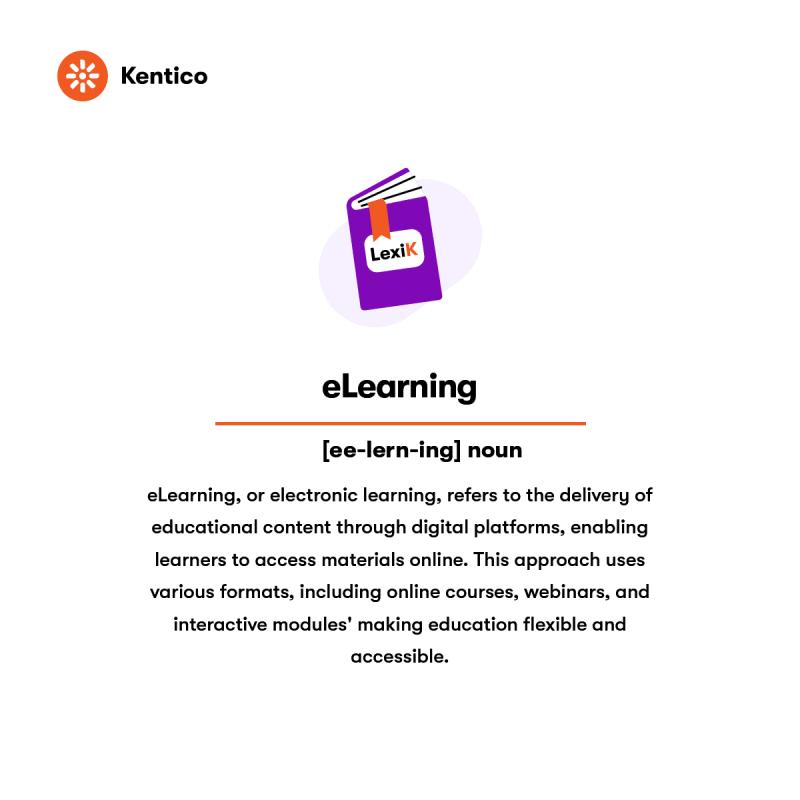In recent years, the shift toward online education has surged, transforming the way institutions approach learning. What once served as a supplemental tool has now become a central pillar of modern education, with students increasingly relying on digital platforms to access lectures, complete assignments, and interact with classmates and professors
According to recent studies, over 70% of students prefer online learning because it offers flexibility and personalized experiences. Which is a good thing as around 4.6 million college students are taking their classes online.
As this digital evolution continues, there is an increasing emphasis on educational institutions to create dynamic, engaging, and seamless online learning experiences that keep students motivated and connected.
In this article, we’ll dive into the key technologies enabling this shift and driving the future of education forward.
LMS: The digital classroom
At the heart of the modern online learning experience lies the learning management system (LMS)—a digital platform that organizes courses, assignments, communication, grading, and much more. LMS platforms today are far more than just repositories of educational content; they are the technological backbone supporting dynamic and personalized learning environments.
As institutions seek to stay competitive and improve student outcomes, the following trends are becoming essential in transforming the digital classroom.
1. Interactive content and gamification
Without the physical presence of a classroom, attention spans can quickly wane, making it essential for educational institutions to use interactive content to maintain focus and encourage deeper learning. Interactive elements—such as quizzes, videos, and simulations—transform passive learning into an active experience, encouraging students to engage directly with the material.
One of the most exciting trends in this space is the rise of gamification in education. By incorporating game-like elements—such as points, levels, and badges—into learning activities, educators can boost motivation by making the learning process more enjoyable. Gamification taps into students' natural desire for competition and achievement, turning lessons and assignments into rewarding challenges. This approach not only enhances engagement but also fosters a sense of accomplishment, making students more likely to stay committed to their online studies.
Students who engaged in gamified learning demonstrated an 11% improvement in factual knowledge and a 9% increase in retention rates compared to those who did not participate in gamified methods. |
2. Video-based learning and virtual classrooms
Video-based learning has quickly become a cornerstone of online education. From live-streamed lessons to pre-recorded lectures and video assessments, video content offers flexibility and accessibility that traditional classrooms can’t match. Students can review material at their own pace, revisit complex concepts, and engage with content in a more dynamic way.
Virtual classrooms, facilitated by platforms like Zoom, Microsoft Teams, or Google Meet, have also become indispensable for synchronous learning experiences, allowing students and teachers to collaborate, ask questions, and participate in discussions—no matter where they are in the world.
A growing trend in video-based education is microlearning, where content is broken down into short, digestible video lessons—catering perfectly to the modern student's preference for quick bursts of information.
93% of teachers believe video increases satisfaction of students with their learning experience and 85% believe it increases student achievements. |
3. AI-powered learning and adaptive technologies
AI is revolutionizing online education by offering personalized learning pathways and adaptive assessments that respond to individual student performance. These tools dynamically adjust course content, pace, and difficulty to meet the unique needs of each learner, creating a more tailored and effective educational experience.
Platforms like Coursera and Knewton are at the forefront of this trend, utilizing AI to deliver customized tutoring and content recommendations based on real-time student progress. This AI-driven approach not only enhances learning outcomes but also keeps students engaged and motivated by providing the right level of support and challenge as they advance through their courses.
AI-driven personalized learning platforms have been shown to improve student outcomes by up to 30%. |
4. Mobile-first learning experiences
Mobile learning is one of the fastest-growing markets within the eLearning industry. Recognizing this trend, many learning management systems and digital platforms are adapting to ensure a seamless mobile experience, allowing students to learn anytime, anywhere.
As students increasingly turn to mobile devices for their educational needs, the importance of mobile compatibility in digital learning tools cannot be overstated.
One powerful feature of mobile learning platforms is the ability to send push notifications. These reminders for upcoming assignments, feedback, or new course content can significantly boost student engagement and completion rates.
Over 70% of students are more motivated to learn when they can do so on their smartphones, and they complete courses 45% faster than their desktop counterparts. |
5. Extended reality: AR and VR
Extended reality (XR), encompassing both augmented reality (AR) and virtual reality (VR), is rapidly transforming the educational landscape by providing immersive learning experiences. These technologies allow students to engage in virtual labs, simulations, and even field trips that enhance understanding, particularly in STEM education.
For instance, platforms like Google Expeditions offer students the opportunity to explore historical sites or biological systems without leaving the classroom, while Labster provides virtual lab simulations where students can conduct experiments safely and effectively. By integrating AR and VR into curricula, educational institutions can foster deeper engagement and a more interactive learning environment.
V-learners (students using VR) are four times more focused during training than their e-learning peers and learn four times faster. |
6. Learning data analytics
Data analytics is emerging as a powerful tool in online education, offering institutions the ability to monitor student progress, engagement, and learning outcomes with greater precision. By using learning analytics tools integrated into LMS platforms, educators can identify at-risk students early and intervene with personalized support. These data-driven insights also help institutions optimize course content, tailoring it to improve student performance and engagement.
However, as data analytics grows in importance, so too does the need for careful management of student data. Privacy and ethical considerations are paramount, ensuring that sensitive information is protected while being used to enhance educational outcomes responsibly.
Predictive analytics are growing to be one of the biggest factors in student success. |
ASU's blueprint for success: Implementing cutting-edge educational trends
One notable example of a university reaping the benefits of implementing emerging educational trends is Arizona State University (ASU). ASU has embraced various innovative practices contributing to improved student engagement and outcomes.
- Data-driven decision making: ASU utilizes a comprehensive analytics platform to track student performance and engagement. This data allows faculty and administration to make informed decisions regarding course offerings and support services, ultimately enhancing student retention and success.
- Adaptive learning technologies: The university has integrated adaptive learning systems into its online courses. These technologies personalize the learning experience by adjusting content and assessments based on individual student performance, ensuring that each student receives the support they need to succeed.
- Mobile learning: ASU has also focused on mobile-friendly learning environments, allowing students to access course materials and resources on their smartphones. This flexibility caters to students' preferences and lifestyle, further increasing engagement.
As a result of these implementations, ASU has seen significant improvements in retention and graduation rates, making it one of the fastest-growing research universities in the United States. The university's commitment to innovation and student-centered practices has positioned it as a leader in higher education reform.
The future of digital learning experiences
As the digital landscape continues to evolve, educational institutions must keep pace with emerging trends to remain competitive, enhance student outcomes, and improve overall satisfaction. By using innovative tools, emphasizing data-driven decision-making, and adaptive learning technologies, educators can create consistent, engaging, and future-proof online learning environments that resonate with learners and complement their existing LMS.
Discover how Xperience by Kentico empowers educational institutions to overcome resource constraints and fragmented digital ecosystems. Download our free ebook, Empower educational excellence: 10 steps to a superior digital experience, to start building seamless, student-centered digital experiences that make a lasting impact.



